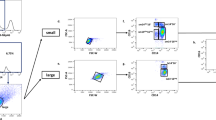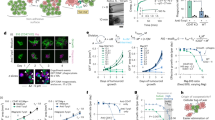Abstract
WE have reported that adherent peritoneal cells from normal mice stimulated the growth of many lymphomas in vitro, while adherent peritoneal cells from mice injected with Bacille Calmette-Guerin (BCG) were far less stimulatory1. The latter were overtly cytostatic when tested on L929 cells1, as well as on several other adherent fibroblastic malignant targets (unpublished). This leads us to speculate that adherent murine peritoneal cells consist of at least two subpopulations, one that tends to stimulate and one that tends to inhibit the proliferation of susceptible target cells. According to this view, infection of the mouse with BCG might lead to increased numbers or activity of the cytostatic subpopulation at the expense of the stimulatory subpopulation. We have now isolated an adherent, esterase-positive, poorly phagocytic mononuclear peritoneal cell with potent tumour-inhibitory capacity, which may represent the postulated cytostatic subpopulation.
This is a preview of subscription content, access via your institution
Access options
Subscribe to this journal
Receive 51 print issues and online access
$199.00 per year
only $3.90 per issue
Buy this article
- Purchase on Springer Link
- Instant access to full article PDF
Prices may be subject to local taxes which are calculated during checkout
Similar content being viewed by others
References
Nathan, C. F., and Terry, W. D., J. exp. Med., 142, 887–902 (1975).
MacMasters, M. M., Baird, P. D., Holzapfel, M. M., and Rist, C. E., Econ. Bot., 9, 300–302 (1975).
Michell, R. H., Pancake, S. J., Noseworthy, J., and Karnovsky, M. L., J. Cell Biol., 40, 216–224 (1969).
Nathan, C. F., Karnovsky, M. L., and David, J. R., J. exp, Med., 133, 1356–1376 (1971).
Rabinovitch, M., and DeStefano, M., In Vitro, 11, 379–381 (1975).
Böyum, A., Scand. J. clin. lab. Invest., 21, Suppl., 97, 77–89 (1968).
Allison, A. C., Ann. Inst. Pasteur, 123, 585–608 (1972).
Greenberg, A. H., Shen, L., and Roitt, I. M., Clin. exp. Immun., 15, 251–259 (1973).
Boyle, M. D. P., and Ormerod, M. G., Cell. Immun., 17, 247–258 (1975).
Zembala, M., and Asherson, G. L., Immunology, 19, 677–681 (1970).
Rice, S. G., and Fishman, M., Cell. Immun., 11, 130–145 (1974).
Walker, W. S., Immunology, 26, 1025–1037 (1974).
Sbarra, A. J., and Karnovsky, M. L., J. biol. Chem., 234, 1355–1362 (1959).
Clark, R. A., Klebanoff, S. J., Einstein, A. B., and Fefer, A., Blood, 45, 161–170 (1975).
Author information
Authors and Affiliations
Rights and permissions
About this article
Cite this article
NATHAN, C., HILL, V. & TERRY, W. Isolation of a subpopulation of adherent peritoneal cells with anti-tumour activity. Nature 260, 146–148 (1976). https://doi.org/10.1038/260146a0
Received:
Accepted:
Issue Date:
DOI: https://doi.org/10.1038/260146a0
This article is cited by
-
Post-infection genetic resistance to avian lymphoid leukosis resides in B target cell
Nature (1977)
-
Macrophages in immunobiology
La Ricerca in Clinica e in Laboratorio (1977)
Comments
By submitting a comment you agree to abide by our Terms and Community Guidelines. If you find something abusive or that does not comply with our terms or guidelines please flag it as inappropriate.



